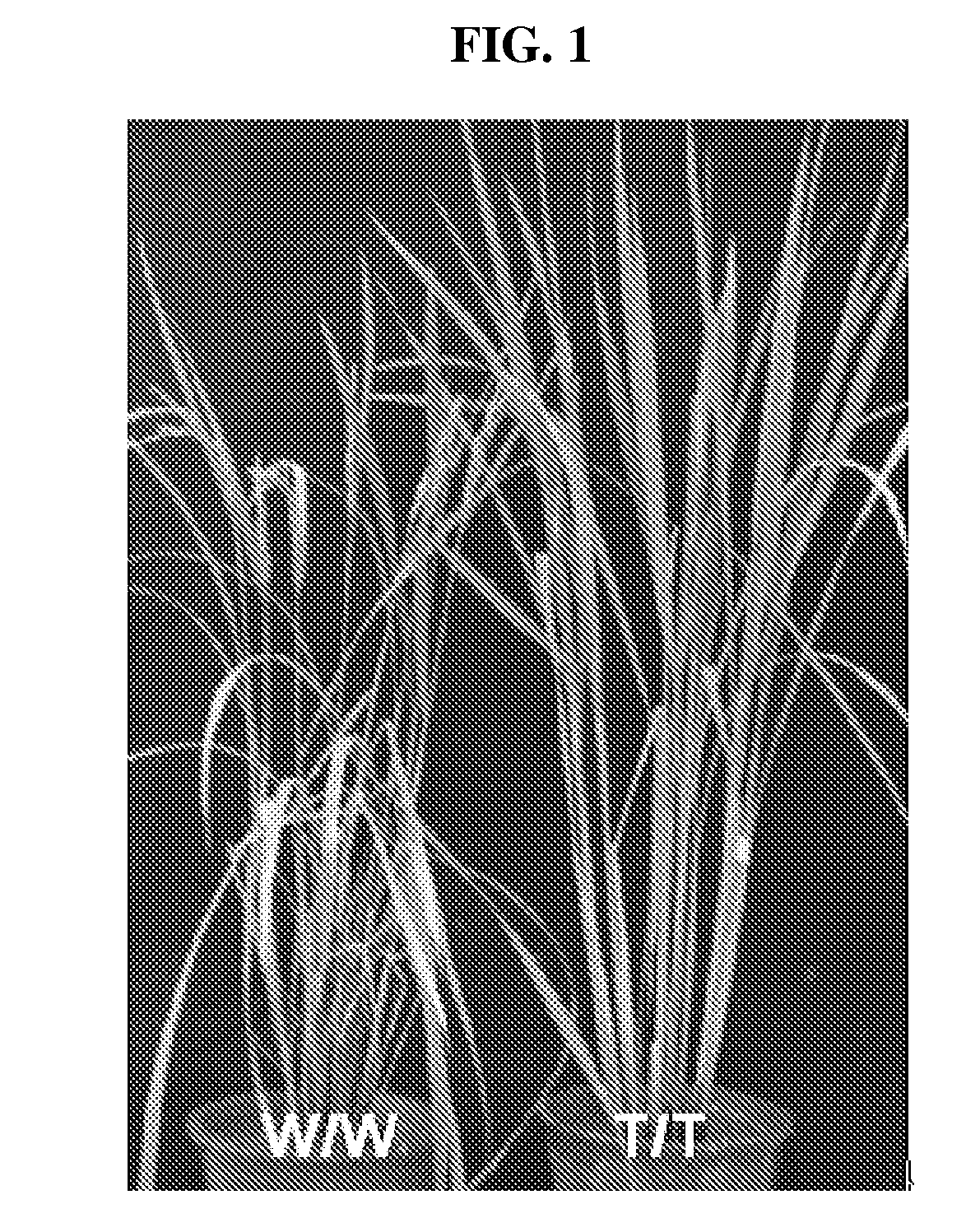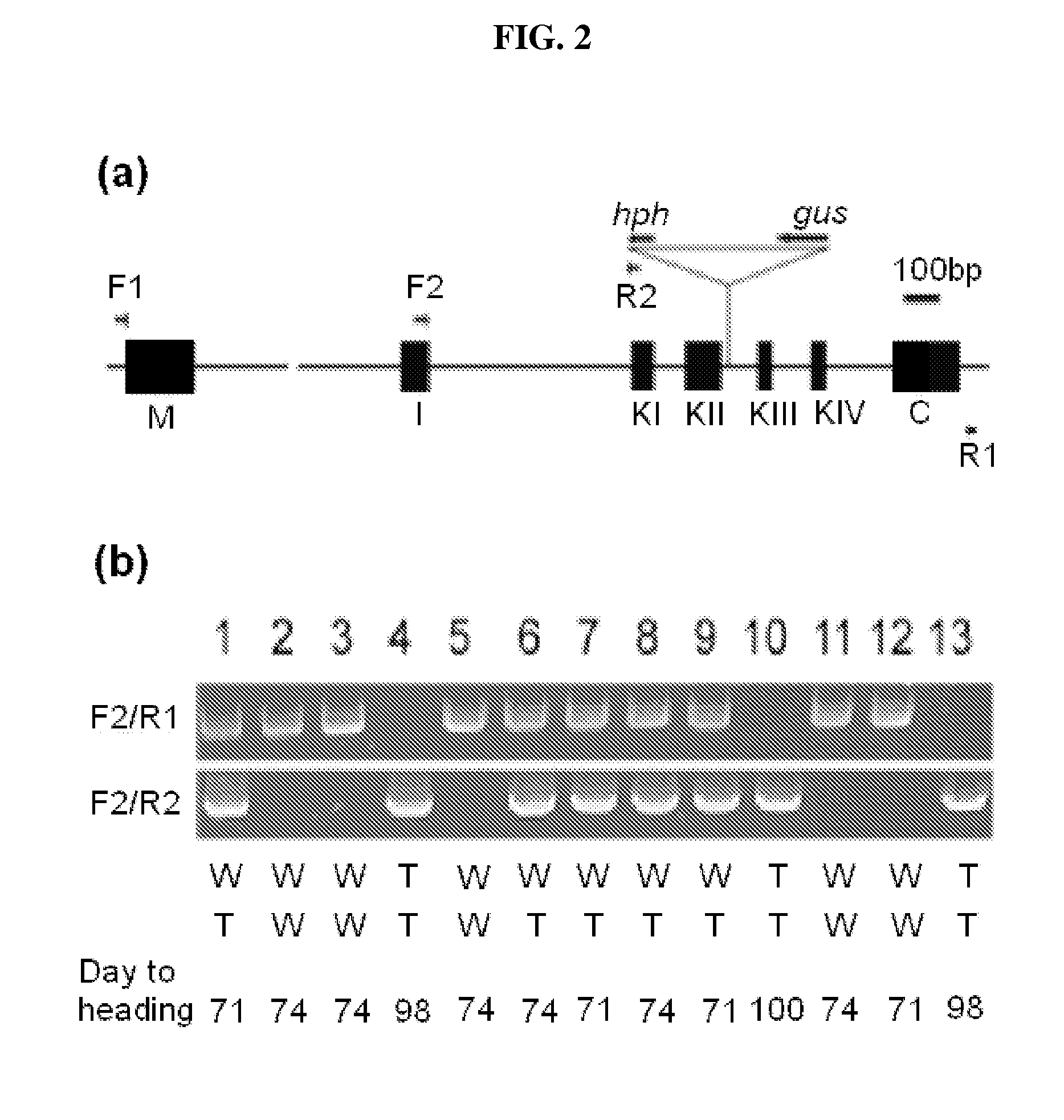Regulator for flowering time, transgenic plant transformed with the same, and method for regulating flowering time
a transgenic plant and flowering time technology, applied in the direction of plant/algae/fungi/lichens ingredients, peptides, dna/rna fragmentation, etc., can solve problems such as inaction, and achieve the effect of accelerating flowering time and delayed flowering tim
- Summary
- Abstract
- Description
- Claims
- Application Information
AI Technical Summary
Benefits of technology
Problems solved by technology
Method used
Image
Examples
example 1
Selection 1 of Flowering-Time Mutants in T-DNA-Tagging Lines
[0089]Rice cells (Oryza sativa var. japonica cv. Dongjin induced calluses) were treated by using Ti plasmid binary vector pGA2144 (Jeon et al., The Plant Journal (2000) 22(6), 561-570), to construct a T-DNA inserted T1 (first generation) mutant lines. The treatment using Ti plasmid binary vector pGA2144 was performed according to “Jeon et al. 2000b”. That is, the rice cells were co-cultivated with agrobacteria, to transport T-DNA into the rice cells, and the T-DNA transported cells were selected by using an antibiotic and re-differentiated. 2933 T1 mutant lines obtained were developed in the field, to produce T2 (second generation) transgenic plants, wherein mutant lines exhibiting alteration in flowering-time were selected. Twenty-five (25) lines exhibiting alteration in flowering-time by at least 2 weeks compared with the flowering-time of the wild-type line were observed, wherein 16 lines exhibited early-flowering phenot...
example 2
Isolation of the OsMADS50 Gene
[0099]The nucleotide sequence of the above OsMADS50 gene is shown in SEQ ID NO: 1. The nucleotide sequence of the OsMADS50 gene is also registered in NCBI database under Accession No. AB003328. However, only the expression profiles in various organs is known, whereas its function is yet unknown (Shinozuka et al., 1999). Herein, the present inventors designed two specific primer pairs, isolated this gene through PCR using the primer pairs, and named the gene OsMADS50. The first PCR was performed for the gene using the primer pair having the nucleotide sequences of SEQ ID NO: 19 (F1: forward at 5′ UTR: 5′-atcaagcttt acggccaaac cctacagc-3′) and SEQ ID NO: 20 (R1: reverse primer at 3′ UTR: 5′-ttgggtaccg atgggtagtg gagtctgc-3′), and then, the second PCR was performed using the PCR amplified product as a template and using a primer pair correspondiing to the nucleotide sequences of SEQ ID NO: 21 (5′-atcaagcttg ttggttcatc ggcgatcg-3′) and SEQ ID NO: 22 (5′-ttg...
example 3
Analysis of OsMADS50 RNA Interference (RNAi) Plants
[0100]To confirm that the late-flowering phenotype is due to the suppression of OsMDS50 gene expression, transgenic plants were generated by expressing RNAi constructs of the gene as shown in FIG. 3a. MAD S-box deleted OsMADS50 genes were cloned into pBluescript SK (−) vector (Stratagene) in opposite directions at both sides of the GUS gene, and then inserted in the pGA1611 vector (AY373338) at the position between the maize ubiquitin promoter (Pubi) and the nos terminator (Tnos). Among 82 T1 plants, 76 showed the delayed flowering phenotype delayed by at least one month (FIG. 3b). Six plants flowered 74 to 78 days after planting, similarly to the wild type control and transgenic controls; eight did not flower until 140 days after planting. These results show that the OsMADS50 gene is an important flowering activator.
[0101]In addition to the late-flowering phenotype, the transgenic plants carried more elongated internodes (FIG. 3c)....
PUM
| Property | Measurement | Unit |
|---|---|---|
| flowering-time | aaaaa | aaaaa |
| time | aaaaa | aaaaa |
| flowering-time | aaaaa | aaaaa |
Abstract
Description
Claims
Application Information
 Login to View More
Login to View More - R&D
- Intellectual Property
- Life Sciences
- Materials
- Tech Scout
- Unparalleled Data Quality
- Higher Quality Content
- 60% Fewer Hallucinations
Browse by: Latest US Patents, China's latest patents, Technical Efficacy Thesaurus, Application Domain, Technology Topic, Popular Technical Reports.
© 2025 PatSnap. All rights reserved.Legal|Privacy policy|Modern Slavery Act Transparency Statement|Sitemap|About US| Contact US: help@patsnap.com



